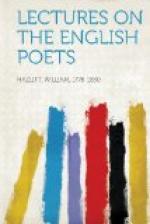“A Sompnoure
was ther with us in that place,
That hadde a fire-red
cherubinnes face,
For sausefleme
he was, with eyen narwe,
As hote he was,
and likerous as a sparwe,
With scalled browes
blake, and pilled berd:
Of his visage
children were sore aferd.
Ther n’as
quicksilver, litarge, ne brimston,
Boras, ceruse,
ne oile of tartre non,
Ne oinement that
wolde clense or bite,
That him might
helpen of his whelkes white,
Ne of the knobbes
sitting on his chekes.
Wel loved he garlike,
onions, and lekes,
And for to drinke
strong win as rede as blood.
Than wolde he
speke, and crie as he were wood.
And whan that
he wel dronken had the win,
Than wold he speken
no word but Latin.
A fewe termes
coude he, two or three,
That he had lerned
out of som decree;
No wonder is,
he heard it all the day.—
In
danger hadde he at his owen gise
The yonge girles
of the diocise,
And knew hir conseil,
and was of hir rede.
A gerlond hadde
he sette upon his hede
As gret as it
were for an alestake:
A bokeler hadde
he made him of a cake.
With him ther
rode a gentil Pardonere—
That hadde a vois
as smale as hath a gote.”
It would be a curious speculation (at least for those who think that the characters of men never change, though manners, opinions, and institutions may) to know what has become of this character of the Sompnoure in the present day; whether or not it has any technical representative in existing professions; into what channels and conduits it has withdrawn itself, where it lurks unseen in cunning obscurity, or else shews its face boldly, pampered into all the insolence of office, in some other shape, as it is deterred or encouraged by circumstances. Chaucer’s characters modernised, upon this principle of historic derivation, would be an useful addition to our knowledge of human nature. But who is there to undertake it?
The descriptions of the equipage, and accoutrements of the two kings of Thrace and Inde, in the Knight’s Tale, are as striking and grand, as the others are lively and natural:
“Ther maist
thou se coming with Palamon
Licurge himself,
the grete king of Trace:
Blake was his
berd, and manly was his face,
The cercles of
his eyen in his hed
They gloweden
betwixen yelwe and red,
And like a griffon
loked he about,
With kemped heres
on his browes stout;
His limmes gret,
his braunes hard and stronge,
His shouldres
brode, his armes round and longe
And as the guise
was in his contree,
Ful highe upon
a char of gold stood he,
With foure white
bolles in the trais.
Instede of cote-armure
on his harnais,
With nayles yelwe,




